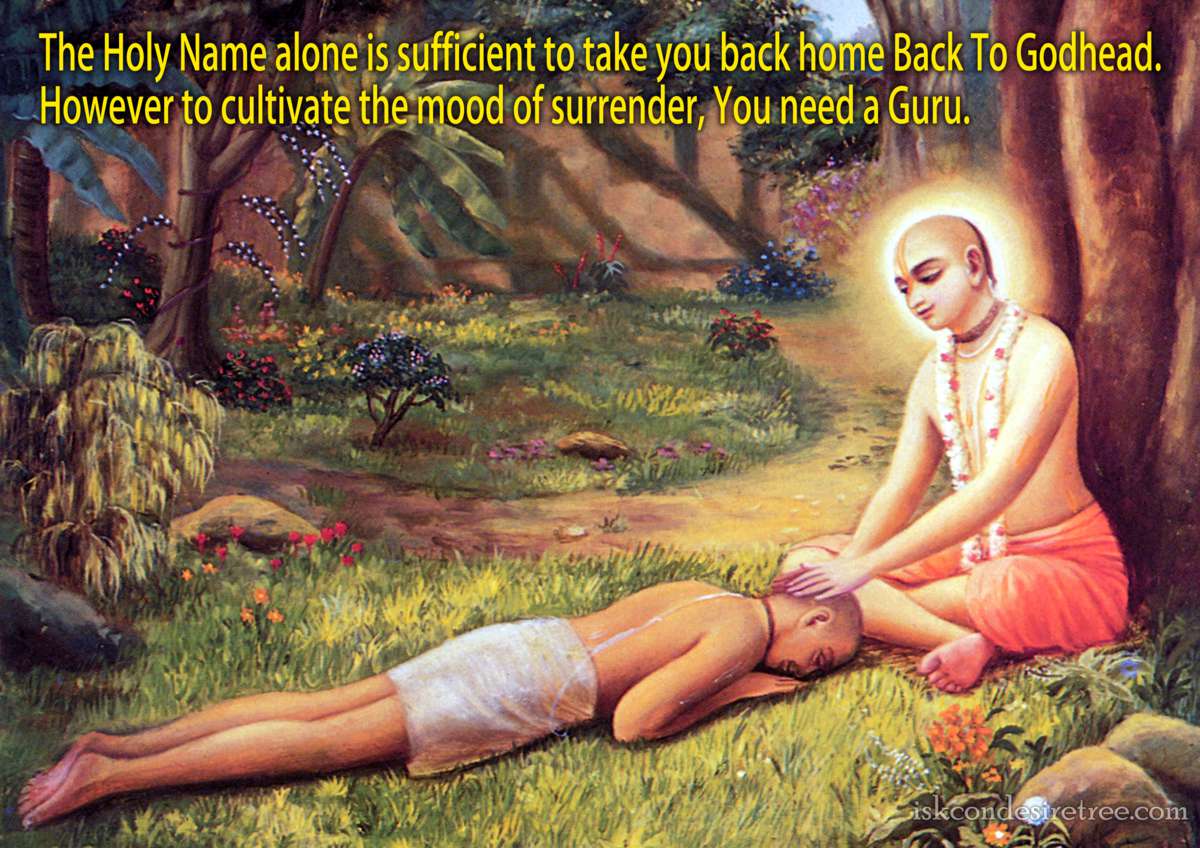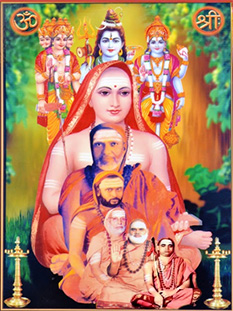Sri Shankara Veda Pathashale Trust [Regd.] draws inspiration and blessings from the Acharyas of Sringeri and offers prostrations at the lotus feet of the Acharyas. No written word can capture the greatness and essence of MahaPurushas (Great Ones). The words of Sri Ramakrishna Paramahamsa aptly sum up this viewpoint: “Everything in the world is defiled by the tongue, except Brahman.”
However, with all earnestness and humility, we have attempted to summarise the lives of Sringeri Acharyas starting from Sri Satchidananda Bharti III to the present Acharya Ananta Vibhushitha Sri Bharati Tirtha by using various official sources.
Sringeri and Guru Parampara
Adi Shankaracharya established the Amnaya Peetham (Vedic Throne) in Sringeri after witnessing an unusual incident—a snake protecting a frog in labour pain. He chose his foremost disciple Shri Sureshwaracharya as the first pontiff. From then on, great yogis and sages have adorned the Seat of Transcendental Wisdom continuously (Avichinna Parampara).The Peetham is the custodian of Yajur Veda. Sage Vidyaranya, the 14th Acharya of the Peetham changed the contours of Indian History by establishing The Vijayanagar Empire.
The Acharyas lead exemplary lives with utmost importance to Dharma Anusthanam (practice), guide seekers of truth and undertake dharmic activities to protect and nurture Sanatana Dharma.
44 years
SRI SACCHIDANANDA BHARATI IIISRI SACCHIDANANDA BHARATI III
One of the titles adorning the Sringeri Acharyas is “Karnataka Simhasana Pratistapanacharya”.The life of Sri Sacchidananda Bharati III aptly illustrates this. Kings and common people venerated him alike for his knowledge and compassion.
The rulers of Mysore (Hyder Ali, Tipu Sultan, and Krishna Raja Wodeyar), Peshwas (Madhav Rao and Baji Rao), Nizams of Hyderabad (Nizam-Ul-Mulk and Nizam Ali Khan) and the East India Company respected and sought the blessings of the Acharya.
As an embodiment of Goddess Saraswathi, the Acharya demonstrated during a debate with the scholars of Mysore Kingdom that Advaita was real and not merely an intellectual exercise. Diwan Purnaiya who doubted the Acharya’s spiritual achievements witnessed the extraordinary feat of Goddess Sharada transforming into the Acharya. This transformed the Diwan, who sought his pardon and vowed to serve the Acharya with devotion.
81 Years
SRI VRUDDHA NRISIMHA BHARATI VIIISRI VRUDDHA NRISIMHA BHARATI VIII
The Swami was born in 1798. When he was young, he had walked all the way to Kasi to study shastras from pandits. He attained complete mastery of all the Shastras and administration activities after becoming the Acharya of Sringeri Mutt. The Acharya conquered sleep and hunger through intense tapas.Tender at heart, he would easily melt at the sight of distressed devotees. The Acharya’s upasana of God Narasimha was constant, which struck awe and reverence in the minds of devotees.
There arevarious anecdotes about Nrisimha Bharati punishing the erring priests of Rameshwaram and Madurai. He also undertook a pilgrimage of North India. The British collector Alexander Nisbet welcomed the Acharya in 1842 and ensured that the Guru received due honours while travelling to Nashik, Dwaraka, Kurukshetra, Kasi, Badarikasrama, Jagannath, etc. Finally, the Mahaswami returned to Sringeri in 1877 and entered Maha Samadhi in 1879.
33 years
SRI SACCHIDANANDA SHIVABHINAVA NRISIMHA BHARATI MAHASWAMIJISRI SACCHIDANANDA SHIVABHINAVA NRISIMHA BHARATI MAHASWAMIJI
His Holiness occupied the Vyakhyana Simhasana (Seat of Transcendental Wisdom) from 1879 to 1912. He was instrumental in discovering Kaladi as the birthplace of Adi Shankaracharya and started the celebration of “Shankara Jayanthi” in India. He was also responsible for discovering the samadhi of Sadashiva Brahmendra, an Avadhuta at Nerur and composed some hymns on him. Hailed as an Avatara of Adi Shankaracharya, the Acharya established vedic schools in Bangalore and other cities. His teachings made such a strong impact on many non-believers (Nastikas) that they became believers (Astikas).
SRI CHANDRASHEKARA BHARATI MAHASWAMIJI
Sri. Narasimha Shastry was initiated into sanyasa at 20 years and given the new name of Sri Chandrashekara Bharati. Pujya Swamiji was always revelling in the bliss of Atma, beyond the three states of experiences (waking, dream and deep sleep) and three bodies (Gross, causal and astral). Although he was the head of Sringeri Mutt, he practically lived the life of an Avadhuta. He had given up wearing Padukasand wore simple cotton dresses without borders. After appointing his successor, His Holiness even stopped using the emblem of the Peetham.
The Acharya had no trace of ego, converted many non-believers into believers (Astikas) by a mere glance, and clarified the doubts of spiritual aspirants in an easy-to-understand manner. The Swami undertook Vijaya Yatras in 1924 and 1938 at the behest of devotees. The Acharya gave up his mortal coil out of His own free will (Videha Mukti) in September 1954. To think of such an exalted Yogi is the greatest blessing humanity can aspire for.
SRI ABHINAVA VIDYATIRTHA MAHASWAMIJI
Srinivasa (pre-monastic name) was born in Bangalore and displayed great wisdom, far sightedness and signs of renunciation at a young age.He had his upanayanam in Sringeri Mutt and continued his studies there. He excelled in studies and caught the eye of Jivanmukta Sri Chandrashekara Bharati. Soon, Srinivasa was initiated into Sanyasa with the new name Sri Abhinava Vidyatirtha. He mastered Raja Yoga as enunciated by Maharishi Patanjali and attained extraordinary heights in meditation. Strange buttrue, his formal lessons in Vedanta commenced after he had experienced complete realization.
The Acharya travelled extensively across India and visited Nepal. He established branch Mutts and consecrated many temples across India. The Mutt attained prosperity and reached great cultural heights under the Acharya despite unfavourable circumstances. The Acharya convened a historic meeting in Sringeri with the Shankaracharyas of Dwaraka, Badri and Puri showcasing unity of thought and action among followers of Adi Shankaracharya.
SRI BHARATI TIRTHA MAHASWAMIJI
Sri Seetharama Anjaneyalu (pre-monastic name) was born in 1951 to a family of Vedic scholars. Even as a young boy, he was inclined towards dharmic way of life and exhibited exemplary knowledge of scriptures and devotion to God. In 1966, the young brahmachari left home finally, reached Ujjain and surrendered to the great Guru Sri Abhinava Vidyatirtha Mahaswami. The Acharya initiated the brahmachari into Sannyasa ashrama in 1974 with the new name Sri Bharati Tirtha Mahaswami.
His knowledge of shastras and Vedanta is vast and unparalleled in modern times.
In 1989, he ascended the Sringeri Peetham as 36th Jagadguru. His compositions on His Guru, previous Gurus and various Gods and Goddesses have been set to soulful music. His qualities of simplicity, patience and humility are emulated by one and all.
As an administrator and scholar par excellence, His Holiness has allowed correspondence in any Indian language or English. The Acharya has undertaken numerous Vijaya Yatrasto instill faith in Sanatana Dharma and ensure that people lead a dharmic life.
In 2015, the Acharya appointed 22-year-old Vedic scholar, Sri Kuppa Venkateshwara Prasad as his successor and initiated him into monastic life under the title Sri Vidhu Shekara Bharati.




